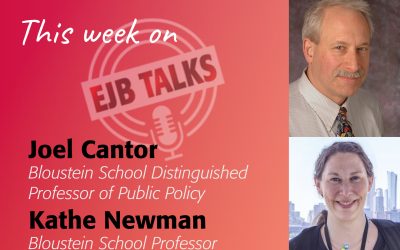“Supply chain” became the buzz phrase at the start of the COVID-19 pandemic when supermarket shelves–and online retailers–were emptied of hand sanitizer, cleaning supplies, and toilet paper. Most of the time how the products we want, or need, arrive at the retailers is not on our minds–unless you drive by an 18-wheeler emblazoned with a particular logo. But as the director of Freight Planning at the North Jersey Transportation Planning Authority, it is Anne Strauss-Wieder’s job to make sure the shelves are stocked with what consumers are looking for. As one of the largest and busiest freight hubs in the U.S., the agencies of the NJTPA were critical during the pandemic’s earliest days in keeping the goods moving from into and through New Jersey. Also an instructor in supply chain management for the Bloustein School, in this episode of EJB Talks, she breaks down the “breakdown” of the supply chain at the start of the pandemic with host Stuart Shapiro.
Stuart Shapiro
Welcome to another episode of EJB Talks. I am Stuart Shapiro, the Associate Dean of the Faculty of the Bloustein School. And the purpose of this podcast is to talk with my colleagues about issues affecting people in New Jersey, the United States and the world. COVID-19 has made us all familiar with the term supply chain management, as we struggle when we go to the store to get hand sanitizer, toilet paper, and other things that three months ago we took for granted. Today I’m talking with Anne Strauss-Wieder with the North Jersey Transportation Planning Authority, an expert in freight and supply chain. Who, in her spare time I’m happy to say, teaches in the Bloustein School urban planning program. And thanks for joining us.
Anne Strauss-Wieder
Thank you, Stuart.
Stuart Shapiro
Anne, can you tell me a little bit about what you do for NJTPA?
Anne Strauss-Wieder
Yes. First a little background as to who NJTPA is. It’s the North Jersey Transportation Planning Authority. We’re the federally authorized Metropolitan Planning Organization responsible for the allocation of about $2 billion a year in federal transportation improvement funding. So, those funds go to transportation such as freight, transit, roadway improvements, bridge improvements, and a variety of other things that go on in the 13-county area. We are a collaboration of agencies, so New Jersey Transit, New Jersey Department of Transportation, the Port Authority, and representatives of the 13 counties and the two major cities in our area are on our board. So in that regard, I’m involved in the freight aspects, and we are very much a major hub of freight activity in the United States.
And just background for the people listening, our region–the 13-county region here is the home to the largest container port on the East Coast and the second largest in North America. Newark Liberty International is the 11th largest air cargo hub in the U.S. We have, in our area, over 833 million square feet of industrial property. And as of the first quarter of 2020, another 14.5 million square feet of industrial property under construction. Containerization actually came from New Jersey from Port Newark, Elizabeth; it started in 1956. And, we’re one of the earliest places where railroading occurred, which means we have a long history in freight activity, but it also means that we have to take that legacy infrastructure and adapt it for 21st century needs.
Stuart Shapiro
Right. I think I’ve noticed a lot of that is driving north on the New Jersey Turnpike there. Can you, can you explain for our listeners what we mean when we say, supply chain management?
Anne Strauss-Wieder
Absolutely. When we talk about supply chains, we talk about how goods move, starting from where the materials are sourced, to where production occurs, and then to where they are consumed. And when we talk about business continuity, that refers to the capacity to continue to deliver products and services, either during or after a disruptive event has occurred.
Stuart Shapiro
Excellent. And you said a disruptive event. We are living through a major disruptive event right now (laughing). That’s a euphemism. The COVID-19 pandemic has had major effects throughout the economy. Can you talk a little bit about why it has disrupted the supply chain?
Anne Strauss-Wieder
So let’s first talk about how to characterize the pandemic. It is one of those lifetime events. We certainly hope that we’re not going to see anything like it again. Now, there’s one thing that supply chain professionals and resiliency professionals have in common. They stay up all night trying to think of what didn’t I think about? And then when that occurs, we pull every effective practice we can add the toolbox and apply it to that situation.
So talking about COVID-19. First of all, we can talk about disruptions in terms of how much time we have to plan for it. For example, say that there’s a planned closure of a road. We have a lot of time to prepare to work around the road. Or they’re predictable disruptions, it’s winter, we know it’s going to snow, we know how to prepare for that. A rapid disruption, okay, maybe we have two or three days notice in the case of a Katrina or Superstorm Sandy. And then we have abrupt disruption such as 9-11. Now COVID-19 was characterized as a rapid disruption. And the other way of characterizing COVID-19, and this is to set our stage for the rest of what we’ll talk about, is by the characteristics of it from a supply chain perspective. Geography, freight facilities affected, commodities and shipments affected, and time to recovery. So, in terms of geographical scope, we’re talking about an international event impacting the entire world, but impacting our local community as well.
Now, when we talk about freight facilities affected, this is where COVID-19 is unique. We’re not talking about infrastructure being disrupted or destroyed. Every mode is online, every region is online. But where it has been disruptive is that, it’s completely altered the demand for freight goods. So let’s talk about that really briefly from your introductory comments. Because we all know, and sometimes joke about, how people prepare for snowstorms in New Jersey. They go and buy eggs and milk and bread. With COVID-19 people are told to shelter in place. Huge demands increase for a lot of products, as well as things needed for the kind of event that occurred. Hand sanitizer, toilet paper, masks, gloves. At the same time, also, we need that personal protective equipment for all our healthcare professionals and our first responders. So massive increases there. Retail stores, offices, production facilities are closed. Demand for what they need–those supply drops all the way down.
Oh, and by the way, us consumers, who started getting used to pointing and clicking on a screen? All of a sudden we’re sheltering in place and we want everything delivered to our homes. So hundreds and hundreds percent increase in how we want the goods to get to us. Now, this is when we start talking, can we keep up with the demand? Because we’re talking about pivoting. For massive new increases in demand, do we have the supplies in place? Do we have production lines in place to carry it? Can we get it there? Think about all those activities necessary to get it to your door in time, especially for consumers used to same-day delivery. So this is where we’re beginning to see the disruptions. But I think this is also the good news here, that so many people have pulled those effective practices out of their toolbox and tried to apply them so that we can continue to ensure that supplies flow in our area.
Stuart Shapiro
So you mentioned that this is a rapid disruption, meaning you had a few days’ notice. It’s also distinct in the sort of length of time it’s taking. I mean, this is not a hurricane, when it’s done in you know, 48, 72 hours or so. We’re now in month three of this going on. And that’s a difference as well, am I right?
Anne Strauss-Wieder
It is. And the first thing that happens in a disruptive situation is you have to focus on the immediate needs. You have to ensure that key supplies continue to flow. You have to build on every existing relationship you have, every collaboration, every bit of knowledge. You have to identify those ranges of needs. Understand that those needs, and the way that you get your supplies, don’t stop at the border of your state or the border of your country. And then very importantly, you have to communicate frequently and concisely. So we all started working together very, very quickly to address the most critical needs as soon as possible. And there’s a lot that goes into that in terms of, thinking through how to make sure everyone gets what they need.
Let me just mention for a bit about the food supply chain, because that has been on a lot of people’s minds. And there were some shortages because there was a huge demand increase. But the food supply chain isn’t just us going to the supermarket or the supermarket coming to us. There are people in food programs that have specific requirements and times they can get food, or they’re relying on Community Food Banks. So the entire spectrum of needs has to be considered in ensuring the welfare of communities. And that’s just one example.
And then we can talk about what the supply chain does because what the supply chain does, is then, responds to that change in demand. So the goods have to flow and we have to talk about long-distance movements and mid-mile movements, and then those last-mile movements. And that was one of the areas, for example, in New Jersey that we all came together on is, making sure that goods continue to flow. For example, you may have heard that the Commonwealth of Pennsylvania, at the beginning of the pandemic, closed all their truck rest areas. Trucks still had to move. And even though the federal government relaxed the hours of service rules for trucks carrying critical supplies, the drivers still needed places to securely park, to use restrooms, to get food, to get fuel. We made sure in New Jersey that those rest stops were open, whether they were private or public. And then NJTPA, we started working with our sister agencies in Pennsylvania, Connecticut, and New York to ensure that the rest areas were open in all four states. And in the case of Pennsylvania, they reopened them as quickly as possible. That’s just one example. And again, lots going on at the port as well.
Stuart Shapiro
That’s one of those things you’d never think of–that truckstop rest areas are, sort of, critical to the functioning of, of our economy there for the very reasons you outlined. That’s a great example. Can you, do you want to talk about a few other things we’re doing to try and make up for disruptions?
Anne Strauss-Wieder
Sure. So let’s talk about the supply chain and what’s going on. And actually, New Jersey has been at the forefront of being proactive in trying to identify those potential bottlenecks and dealing with them ahead of time. So for example, with the port. As I mentioned certain businesses closed. The retail chains, some of the restaurants, businesses, production lines. There was a concern that containers could be coming in, but there was no one there to receive them or they didn’t want the goods. So, the Port Authority and a bunch of us worked together to get a survey out to all the receivers of products, asking if they had the facilities on hand to receive that cargo over the next four-week period. At the same time, the Port Authority started gathering an inventory of available space, both within buildings and hardstand space. So if the original receiver did not want to receive the container, there was someplace it could go. It didn’t have to stack up at the port. So that was working through those situations ahead of time. It was making sure that personal protective equipment, PPE equipment, was made available to everyone in the supply chain.
And another very critical aspect is workforce. Think about all the people necessary if we want our products delivered to our house. The goods have to be picked at supermarkets, they have to be picked in the warehouses, they have to be transported. Folks like Instacart, UPS, Amazon–hiring thousands of people. At the same time, thousands of people were furloughed in New Jersey. So the state of New Jersey created a COVID-19 job and hiring portal and made sure that everyone could have access to it and very easily find jobs that were open, say, at Amazon or ShopRite or UPS, and apply for those. And they also worked to deal with other little potential hiccups. For example, high school students, who may need the written permission of their principal to work in a supermarket, but you can’t get the written permission. So these little details were all worked out ahead of time.
Now we’re in a different situation, we’ve entered a different realm with the pandemic, where we are looking at some of the major shifts in goods flowing. For example, we have something now called blank sailings of container vessels. It means the vessel has basically been canceled. So there are a lot fewer vessels calling at the port now. So we do have to think about the workforce at the port. And at some point, it’s going to grow. We do know that there will be a lot of blank sailings in June, probably the highest number so far. But that number is reduced by more than half, and it starts coming back in July from what we can see.
But we’re already seeing some of the trends coming out of the pandemic. They’re going to be affecting us in the short and longer-term. For example, some of the retailers in apparel are skipping a season. So instead of, you know, getting the summer gear and the beach towels, they’ve skipped it, because they’ve canceled their orders. It’s just not enough time. And the demand just isn’t there. So, we’re already beginning to think through, what do we need now as we move into this new stage, or past what I’ll call the whack-a-mole, dealing with the day-to-day trouble in the supply chain. We know how things are going. And we’re also beginning to think about where things are headed.
Stuart Shapiro
Right I mean, we could have another similar disruption in the fall if some of the epidemiologists are to be believed there. And so, obviously, you’re thinking about that as well, I’m sure. You mentioned the sailings that have been canceled, the shipments have been canceled. And that brings me to my next question. How is the globalization of many of our supply chains really helped or hurt us through this crisis?
Anne Strauss-Wieder
And that’s actually something we talk about in my class as well. Because if this…
Stuart Shapiro
Is that so?
Anne Strauss-Wieder
Yes, because if this was the 1950s or 1960s, the typical supply chain back then was about 200 miles. And with globalization, our supply chains became thousands of miles. Because again, when we look at the definition of supply chain, there are a variety of places where we source products, there are a variety of places where we produce goods, and obviously, where we sell goods. So it’s always a balancing act, Economics 101, the best source from a cost perspective, the best production location from a cost perspective, and getting it to the end consumer. So this is where we really saw some of the issues occurring. Because in some cases, countries closed their borders, nothing was going in and out. Some factories were closing so that we couldn’t get raw materials.
So this is where the supply chain professionals really go into full gear and into battle mode. And they also start thinking about what they have to do better in the future. Because in supply chain, it’s one strike and you’re out. They don’t ever let something happen again. So here it is, taking a look first of all, at the suppliers. Do I have a deep enough bench? And at production locations, there was already a shift out of China way before this occurred. And part of that had to do with costs. And another was because of what happened with the terrible disaster in Fukushima, where there were supply chains disrupted around the world because the only plant for example, to produce a particular element needed for metallic paint in cars was produced in that area, and it shut down everybody. So there’s been a diversification of production locations. So yes, so that’s one of it, is looking at where you’re producing things.
Now, you mentioned toilet paper, and the shortage that occurred and we could be on a roll here. But…
Stuart Shapiro
That was a great pun, by the way. (laughing)
Anne Strauss-Wieder
(laughing) But think about toilet paper for a moment. It’s not just what we have in our homes. But, the kind of toilet paper that is found in office buildings or restaurants. They’re different size rolls. They are different size setups for the containers, and they are different dimensions and different delivery patterns. So basically, the companies that produce them had to figure out how they could pivot their production lines to make the products that consumers needed, at the same time that businesses and restaurants were closed. So it’s not just the supply chain, the ability to move the product. But it’s the ability to pivot your production to what you need.
And that also goes back to what you said with suppliers. So, if you take a look at where you’re eggs are coming from. They’re not the same suppliers necessarily that you’ve seen before. So that’s that deep bench of suppliers. And that will be one of the lessons that are coming out of this particular pandemic, really looking at that deep bench. There as an acceleration of trends in terms of looking at what industries we want here in the U.S., what may be near sure, and what is going to take a much longer time to come back. So, there is some movement already that was occurring before the pandemic. If anything, some of the trends that we see coming out of it, because this is very much a trend breaker situation, is an acceleration of existing trends that we’ve been seeing before the pandemic.
Stuart Shapiro
Let me conclude with a follow up on that question. You mentioned lessons. Can you talk about what you think are the big lessons from what we’ve gone through over the past few months?
Anne Strauss-Wieder
Oh, definitely. First of all, it is having that toolbox of effective practices. It’s knowing how to identify potential risks, and consequences, and mitigation strategies. It’s the ability to build on existing relationships and expertise to be able to identify what is most critically needed and how do I make that happen. And, doing that ahead of time. It’s the ability to pivot to be flexible, to collaborate; whether it’s among agencies, whether it’s public-private, but the bottom line is to get things done. Absolutely crucial is communications. Communications among organizations, communications to the public, communications to suppliers. Communications that are precise and understandable and continue to occur. And very importantly, it is not only to think about the short-term needs but also to begin thinking about the longer-term implications for business and community continuity.
Stuart Shapiro
That’s great. I will say, I think this is the podcast of which I’ve probably learned the most. It’s a little bit of a function of things I know and don’t know. But it’s been extremely educational having you on and thanks so much for coming on today Anne.
Anne Strauss-Wieder
Thank you very much.
Stuart Shapiro
I’d also like to give a thank you to our production team– Tamara Swedberg, Amy Cobb and Karyn Olsen. We’ll be back next week with another talk with another expert from the Bloustein School. Thanks for listening.




